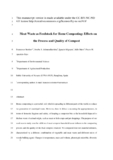Mostrar el registro sencillo del ítem
Meat waste as feedstock for home composting: effects on the process and quality of compost
| dc.creator | Storino, Francesco | es_ES |
| dc.creator | Sánchez Arizmendiarrieta, Joseba | es_ES |
| dc.creator | Irigoyen Iriarte, Ignacio | es_ES |
| dc.creator | Muro Erreguerena, Julio | es_ES |
| dc.creator | Aparicio Tejo, Pedro María | es_ES |
| dc.date.accessioned | 2017-05-02T09:53:43Z | |
| dc.date.available | 2018-10-01T23:00:11Z | |
| dc.date.issued | 2016 | |
| dc.identifier.issn | 0956-053X (Print) | |
| dc.identifier.issn | 1879-2456 (Electronic) | |
| dc.identifier.uri | https://hdl.handle.net/2454/24148 | |
| dc.description.abstract | Home composting is a powerful tool, which is spreading in different parts of the world, to reduce the generation of municipal waste. However, there is debate concerning the appropriateness, in terms of domestic hygiene and safety, of keeping a composter bin in the household deputed to kitchen waste of animal origin, such as meat or fish scraps and pet droppings. The purpose of our work was to study how the addition of meat scraps to household waste influences the composting process and the quality of the final compost obtained. We compared four raw material mixtures, characterized by a different combination of vegetable and meat waste and different ratios of woody bulking agent. Changes in temperature, mass and volume, phenotypic microbial diversity (by Biolog TM) and organic matter humification were determined during the process. At the end of the experiment, the four composts were weighed and characterized by physicochemical analysis. In addition, the presence of viable weed seeds was investigated and a germination bioassay was carried out to determine the level of phytotoxicity. Finally, the levels of pathogens (E. coli and Salmonella spp.) were also determined in the final compost. Here we show that the presence of meat waste as raw feedstock for composting in bins can improve the activity of the process, the physicochemical characteristics and maturity of the compost obtained, without significantly affecting its salinity, pH and phytotoxicity. Pathogen levels were low, showing that they can be controlled by an intensive management and proper handling of the composter bins. | en |
| dc.description.sponsorship | The experiments were financially supported by the Spanish Ministry of Science and Technology (Project AGL2012-37815- C05-05). | en |
| dc.format.mimetype | application/pdf | en |
| dc.language.iso | eng | en |
| dc.publisher | Elsevier | en |
| dc.relation.ispartof | Waste Management 56 (2016) 53–62 | en |
| dc.rights | © 2016 Elsevier Ltd. The manuscript version is made available under the CC BY-NC-ND 4.0 license. | en |
| dc.rights.uri | https://creativecommons.org/licenses/by-nc-nd/4.0/ | |
| dc.subject | Compostaje doméstico | es_ES |
| dc.subject | Prevención de residuos | es_ES |
| dc.subject | Residuos cárnicos | es_ES |
| dc.subject | Patógenos humanos | es_ES |
| dc.subject | Calidad del compost | es_ES |
| dc.subject | Home composting | en |
| dc.subject | Waste prevention | en |
| dc.subject | Meat waste | en |
| dc.subject | Compost quality | en |
| dc.subject | Human pathogens | en |
| dc.title | Meat waste as feedstock for home composting: effects on the process and quality of compost | en |
| dc.type | Artículo / Artikulua | es |
| dc.type | info:eu-repo/semantics/article | en |
| dc.contributor.department | Ciencias del Medio Natural | es_ES |
| dc.contributor.department | Natura Ingurunearen Zientziak | eu |
| dc.contributor.department | Producción Agraria | es_ES |
| dc.contributor.department | Nekazaritza Ekoizpena | eu |
| dc.rights.accessRights | Acceso abierto / Sarbide irekia | es |
| dc.rights.accessRights | info:eu-repo/semantics/openAccess | en |
| dc.embargo.terms | 2018-10-01 | |
| dc.identifier.doi | 10.1016/j.wasman.2016.07.004 | |
| dc.relation.projectID | info:eu-repo/grantAgreement/MINECO//AGL2012-37815-C05-05/ES/ | en |
| dc.relation.publisherversion | https://dx.doi.org/10.1016/j.wasman.2016.07.004 | |
| dc.type.version | Versión aceptada / Onetsi den bertsioa | es |
| dc.type.version | info:eu-repo/semantics/acceptedVersion | en |






